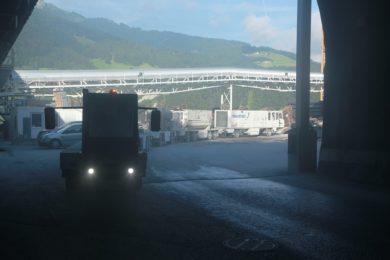Building on a world first demonstration of fully autonomous transportation of a tunnel boring machine (TBM) using trackless VirtuRail® trains at the Brenner Base Tunnel project, in Austria, in December, MobileTronics is setting new goals.
The demonstration took place on the construction site ‘Ahrental’ of the STRABAG and Salini Impregilo-owned project, near Innsbruck, with the supply of the TBM realised by trackless trains. These rubber-tyred, about 60-m long trains consist of five single cars and enable continuous transport from the loading area to the TBM, via a 2.5-km long access tunnel set at a decline of close to 12%.
MobileTronics’ VirtuRail System steers all 18 axles electronically, allowing precision handling where all axles follow the first in line. An additional driver assistance system guides the first axle automatically in the tunnel and is also used for obstacle detection. This system can guide the train around a 90°curve on 30 m radius at the end of the access tunnel.
As MobileTronics’ Christoph Mueller and George Biro said, this autonomous operation did not take place in a closed special purpose area; all tests, as well as the showcase, took place in the regular working environment of the tunnelling construction site.
Mueller and Biro said: “Extending the existing application to a fully autonomous system working safely in the tunnelling environment, from the technical point of view, would not require more than three to four months.
“The main effort would be to install a central supervision workplace, which provides a central overview of the locations and status of the trains together with live video and the possibility for the remote operator to restart and manually manoeuvre in exceptional situations.”
For future autonomous operation, the availability of a mechanical vehicle originally intended for fully autonomous operation, “with an optimised technical reliability of the underlying mechanic and hydraulic systems would be required”, according to Mueller and Biro.
The company is also looking at completing a fully-electric operation as it looks to reduce emissions and boost environmental credentials. “This would also save significant cost for tunnel ventilation compared to diesel-operated machines,” the company said, adding that the electric vehicles were also likely to provide lower operating costs due to higher energy efficiency.
“In the following projects, MobileTronics already has gained extensive experience in integration of battery- and hybrid-powered electric vehicles as well as in integration and configuration of the high voltage electric components including motors and frequency converters,” Mueller and Biro said.
“The future VirtuRail trains, therefore, will be modular products made of reliable components designed for fully-autonomous operation, however with the option of manual operation from two cabins or only one driver cabin.”
The applications for VirtuRail are not limited to TBM supply operations, with the trains potentially being used in mining for raw material transport: “In underground mines, for example, the use of rubber-tyred trains has the potential to replace dedicated train transport levels which will speed up the mining operations as the separate transport level does not need to be excavated before mass mining starts,” Mueller and Biro said.
They continued: “Also in surface mining, VirtuRail trains have the potential to become an alternative to conveyor belt installations or traditional truck transport.”










